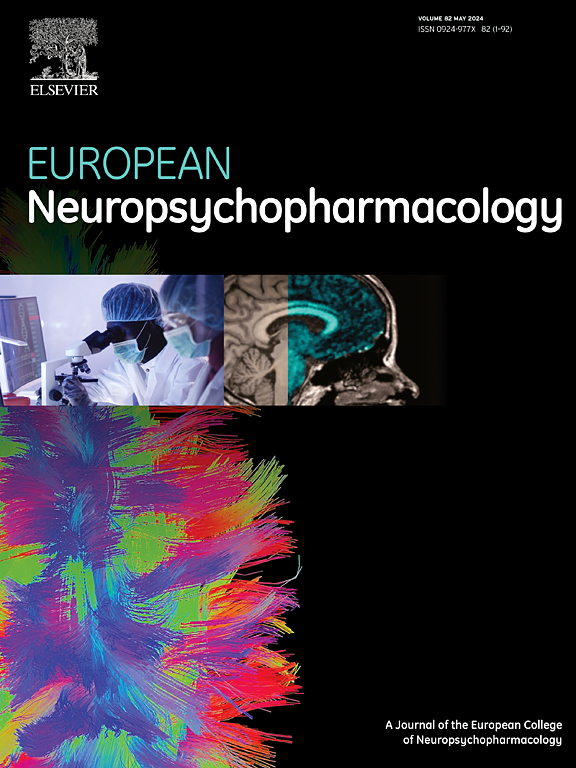多祖先精细图谱揭示了双相情感障碍的风险基因,并强调了药物再利用的机会
IF 6.7
2区 医学
Q1 CLINICAL NEUROLOGY
引用次数: 0
摘要
全基因组关联研究(GWAS)已经确定了数百个与双相情感障碍(BD)风险相关的基因座,但由于风险变异之间的连锁不平衡(LD)和对大脑非编码调节机制的不完全了解,确定因果变异及其功能角色仍然是一个挑战。最新的多血统GWAS荟萃分析-整合了来自欧洲,东亚,非洲裔美国人和拉丁裔队列(包括158,036例病例和2,796,499例对照)的数据-确定了298个与bd相关的全基因组显著位点。为了缩小这些相关区域,我们应用了SuSiEx,一种利用不同人群LD结构的统计精细映射方法,使我们能够在这298个位点中优先考虑113个可能的因果单核苷酸多态性(snp)。然后将这些snp映射到相应的基因上,并通过整合几条证据来探索它们在双相障碍中的功能作用。首先,我们采用基于汇总数据的孟德尔随机化(SMR)在脑体积组织数量性状位点(qtl)覆盖表达、剪接和甲基化qtl的背景下解释这些snp。接下来,我们使用新发表的脑单核eqtl资源的SMR分析来完善这些效应的细胞类型特异性。我们的综合分析突出了几个候选基因,包括TRANK1、CACNA1B、BCL11B、RGPD8、SP4和POU6F2,这些优先snp显示出对抑制性和兴奋性神经元以及少突胶质细胞和星形胶质细胞特异性的调节作用。这些观察结果暗示了未来功能研究的潜在目标,旨在提高我们对双相障碍生物学机制的理解。未来的方向包括利用Drugbank和药物基因相互作用数据库(DGIdb)等资源进行药物再利用分析,以评估现有药物是否可以调节这些候选基因,从而为双相障碍提供创新的治疗方法。本文章由计算机程序翻译,如有差异,请以英文原文为准。
MULTI-ANCESTRY FINE-MAPPING REVEALS BIPOLAR DISORDER RISK GENES AND HIGHLIGHTS DRUG REPURPOSING OPPORTUNITIES
Genome wide association studies (GWAS) have identified hundreds of loci contributing to bipolar disorder (BD) risk, yet identifying the causal variants and their functional roles remains a challenge owing to linkage disequilibrium (LD) between risk variants, and incomplete understanding of the non-coding regulatory mechanisms in the brain. The latest multi-ancestry GWAS meta-analysis—which integrated data from European, East Asian, African American, and Latino cohorts (comprising 158,036 cases and 2,796,499 controls)— identified 298 genome-wide significant loci for BD.
To narrow down these associated regions, we applied SuSiEx, a statistical fine-mapping method that leverages the varied LD architecture across populations, allowing us to prioritize 113 likely causal single-nucleotide polymorphisms (SNPs) within these 298 loci. These SNPs were then mapped to their corresponding genes, and we explored their functional roles for BD by integrating several lines of evidence. First, we employed Summary data-based Mendelian Randomization (SMR) to interpret these SNPs within the context of brain bulk tissue quantitative trait loci (QTLs)—covering expression, splicing, and methylation QTLs. Next, we refined the cell-type specificity of these effects using SMR analysis on a newly published resource of brain single nuclei eQTLs.
Our integrative analysis highlighted several candidate genes, including TRANK1, CACNA1B, BCL11B, RGPD8, SP4 and POU6F2, with prioritized SNPs showing regulatory effects that are specific to inhibitory and excitatory neurons as well as oligodendrocytes and astrocytes. These observations hint at potential targets for future functional studies aiming to improve our understanding of the biological mechanisms underlying BD. Future directions include drug repurposing analyses using resources such as Drugbank and the Drug Gene Interaction Database (DGIdb), to assess whether existing drugs might modulate these candidate genes to offer innovative treatments for BD.
求助全文
通过发布文献求助,成功后即可免费获取论文全文。
去求助
来源期刊

European Neuropsychopharmacology
医学-精神病学
CiteScore
10.30
自引率
5.40%
发文量
730
审稿时长
41 days
期刊介绍:
European Neuropsychopharmacology is the official publication of the European College of Neuropsychopharmacology (ECNP). In accordance with the mission of the College, the journal focuses on clinical and basic science contributions that advance our understanding of brain function and human behaviour and enable translation into improved treatments and enhanced public health impact in psychiatry. Recent years have been characterized by exciting advances in basic knowledge and available experimental techniques in neuroscience and genomics. However, clinical translation of these findings has not been as rapid. The journal aims to narrow this gap by promoting findings that are expected to have a major impact on both our understanding of the biological bases of mental disorders and the development and improvement of treatments, ideally paving the way for prevention and recovery.
 求助内容:
求助内容: 应助结果提醒方式:
应助结果提醒方式:


